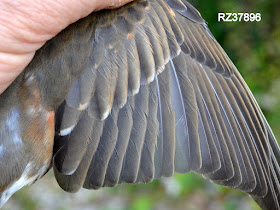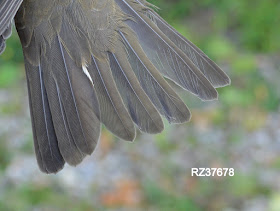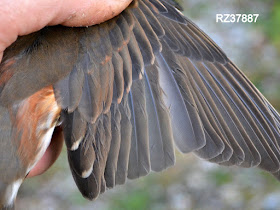I wasn't sure if I should just do this as a post or as a page but have decided on the latter as it makes it easier for me to access and update if I want to add new photos or if new information comes to light. I probably should have done this with the Goldfinch ageing and sexing posts that I have published in the past as they have proved to be incredibly popular with around 20,000 views combined, and that number is still growing.
Whilst Redwings are relatively easy to age in the main there are some that are a bit more challenging and a few that are better left unaged. I can't give precise figures on this but I would say a around 80 or 90% can be quickly and confidently aged but the remainder need more of a thorough looking over. Another reason for not giving any precise figures is that perceptions of what is easy or difficult to age will vary between ringers depending on their experience, training and the ageing guides used. In addition the circumstances in which birds are caught can also make a difference with birds caught at roost or at first light being processed with the aid of artificial light which can make some plumage details more difficult to see.
The ageing guides that will be referred to are Svensson's Identification Guide to European Passerines (4th edition), Moult and ageing of European passerines by Jenni & Winkler and the Ringers Digiguide on the Ottenby Bird Observatory website and will be abbreviated as Sven, J&W and Ott respectively. All the ageing guides give similar descriptions of adults and juveniles and illustrate the differences with drawings or photographs although J&W doesn't show any images of the tail.
One thing I would say about these guides is that they don't adequately show or describe the variation in the appearance of the key features that both adults and first year birds can display and, in my experience, that is where the difficulty lies. The description and image of adult greater coverts in J&W suggest that adults don't have any pale tips while Ott does indicate that some adults can have deeper pale markings that can approach the pattern found on juveniles but they don't show a good example of an adult wing with such markings. In my experience quite a few adults can have strong and more or less angular pale markings on the tips of the greater coverts that could easily be mistaken for juvenile feathers and some even have markings that mimic a moult limit.
All of the guides give details of the extent of the post juvenile moult which includes the body feathers, lesser coverts and median coverts. Some greater coverts are also replaced but very few birds replace them all. One or more tertials may also be replaced and in a small proportion of birds the central pair of tail feathers (R1) is also replaced but such occurrences are generally considered to be rare. Adults have a complete moult as you would expect.
The aim of this article is to show some of the variation that I have encountered this autumn (2016) and hopefully the images will supplement the ageing guides referred to above. It should be noted that I didn't confirm the age of any of the birds by looking at skull ossification so any age given is solely based on the plumage features shown. An image of the wing and tail are shown for each bird so you get to see all the key features as I did. In some instances the wing is shown first followed by the tail and in others they are shown the other way round but the ring number is shown on each image to help avoid any confusion.
Lets have a look at some images and where better to start than with couple easy birds, a first year bird (1cy) and an adult (2cy+).
 |
| An example of a very plain adult wing. If all adults looked like this ageing all Redwings would be easy. This is similar to the only example of an adult wing shown in J&W but there are plenty of adults that don't look like this. |
 |
| A fairly typical adult tail with broad rounded tips. The feathers are relatively fresh compared with the juvenile above being more olive and glossy. |
Now to show that it was not a 'one off' lets have a look at another four similar birds.
RZ37774
 |
| Again the very broad and rounded tail feathers suggested it was an adults and I have no doubt that is what it is. |
RZ37678
 |
| An adult tail with all tail feathers fresh, broad and rounded. |
 |
| Here is a better view of the same tail. So again an adult with a well marked wing. |
RZ37707
 |
| Here we have yet another adult with large and quite well defined pale tips to all the greater coverts along with well marked medians. |
 |
| Again the whole tail is relatively fresh and all of the feathers are broad and rounded and there is no doubt in my mind that it is an adult. |
That prompted me to look at the plumage descriptions and information on moult in the Birds of the Western Palearctic (BWP) in which the juvenile (3J) lesser and median coverts are described as having a buff shaft streak, narrowing to a point towards the base and widening towards the tip to form a broad buff triangular spot, which is a rather long winded way of saying a buff elongated thorn shaped marking. BWP also states that the pj moult includes head, body, lesser coverts, median coverts, some inner (rarely all) greater coverts, and rarely some tertials or tail feathers. It can be deduced, therefore, that the rufous thorn shaped markings on the median coverts of the birds shown above cannot be retained juvenile feathers as they are the wrong colour and don't extend far enough along the shaft. Furthermore the fact that they all have adult tails removes any chance of them being anything other than adults except for the rather remote possibility of one or more being juveniles that have replaced the entire tail following accidental loss. Now all that may seem glaringly obvious but I wanted to show that all possibilities have been considered for the sake of completeness.
So what about that marking on the innermost greater covert of RZ37896, well it is almost identical to the innermost greater covert of one of the adults shown in the Ott guide (link to image here). Ott does say that the tips of the adult greater coverts can vary to some extent but then goes on to say that they usually only show a narrow and diffuse pale edge. The guide doesn't draw attention to or make any direct comment about that particular feather in that example of an adult wing and the only reason I have done so is to show that a bird with a similar marking on the innermost greater covert was aged as an adult.
The adults with well marked medians that have been shown above also have well marked greater coverts but some adults just have well marked medians and their greater coverts can be quite plain, as can be seen with RZ37726 below. While the appearance of the median coverts has no significance when it comes to ageing Redwings in autumn they can be a bit of a distraction or at least I think so. The markings on the medians of this adult are not that dissimilar to those described for juveniles (3Js) in BWP other than being more rufous in colour, the inner medians even have quite long shaft streaks.
Now lets have a look at another interesting bird.
 |
| This bird appears to show a moult limit in the greater coverts and anyone using any of the ageing guides could easily come to that conclusion but what does the tail look like. |
 |
| Clearly an adult tail with all feathers being fresh, broad and rounded. I played safe with this bird and left it unaged at the time of ringing although I did think is was an adult and still do. |
Now lets have a look at another bird with a fairly similar wing to RZ37636 above.
 |
| The tail is very pointed and clearly that of a juvenile. |
Some of you may still be thinking RZ37636 it is a first year bird that has replaced the entire tail but as I have said before the literature is very consistent in saying that juveniles rarely moult any tail feathers and, in the very small proportion that do, it is usually limited to the central pair (R1). That still leaves the possibility of it being a first year bird that has replaced its entire tail after accidental loss but while I am sure that can happen it must be a relatively rare occurrence. Furthermore, the chances of so many accident prone Redwings coming my way and being the explanation for this bird or any of the others must be so incredibly small that it can be ruled out. Having said that birds like RZ37636 are better left unaged unless the age is confirmed by other means such as the ossification of the skull.
Again just to show that RZ37636 was not a one off in appearing to have a moult limit in the greater coverts here is another example.
 |
| Once again the tail tells a very different story and it is clearly an adult. |
At this point I want to to show images of a first year bird that clearly demonstrates that post juvenile greater coverts can be well marked.
 |
| The bird had a juvenile tail as is to be expected and it is worth noting that it hadn't replaced any tail feathers, not even the central pair. It is also worth noting that the tail feathers are quite broad overall compared to some of the other first year birds shown and one thing I have noticed in looking at a lot of Redwings is that the overall width of the tail feathers varies considerably within both age classes. |
All of the adults shown up to now have had broad rounded tail feathers but there is some variation in tail shape too. The Ott guide illustrates the variation in shape of the tail feathers of the two age classes and effectively shows that some adults can have quite pointed tail feathers that are more or less identical in shape to some first year birds. While there can be some overlap in the shape of the tail feathers there is usually an obvious difference in feather quality and wear as mentioned previously, but even this isn't totally foolproof and there can be a degree of overlap in appearance in terms of quality and wear too. So lets have a look at a few examples.
RZ12788
 |
| The central pair of tail feathers were particularly narrow and pointed in this adult but all the tail feathers were quite fresh and had a good gloss. |
 |
| The wing was the very plain adult variety.
RZ37971
|
 |
| The central pair of tail feathers were quite pointed on this adult too but the rest of the tail shouldn't kid anyone having broad and well rounded tips. |
 |
| The wing was about as plain as they come and looks good for an adult. |
RZ37554
 |
| This tail is fairly pointed and suggest it belongs to a first year although it was more like an adult in terms of feather quality, colour and wear so what did the wing look like. |
 |
| Well the wing was very plain and strongly pointed to it being an adult and but I left it unaged just to play safe. I actually think this bird is an adult and if you don't think adults can have such a pointed tail check out the tail images on the OTT site (link here) |
 |
| A very plain wing and there isn't anything that jumps out to suggest that it belongs to a first year bird but what did the tail look like. |
I thought it would be worth showing some images of first year birds that have replaced some tail feathers. There wasn't anything difficult about ageing any of these birds, they are simply included for reference.
RZ12792
 |
| This first year bird has replaced R1, R5 R6 on the birds left (right as viewed) and R6 on the right (left as viewed). |
RZ37556
 |
| In this first year R1, R2 and R6 on the right and R1, R3, R4 and R6 have been replaced. |
 |
| The wing of this first year was also very plain but again there is a moult limit between the 2nd and 3rd greater covert. |
 |
| In this first year only R1 on the bird's left has bee replaced. Interestingly in this and the other 2 examples above the new tail feathers are shorter than unmoulted juvenile tail feathers. |
 |
| In this individual there was no obvious moult limit in the greater coverts but the tertials are more strongly marked. |
Nearly finished now but I have two more birds I want to show you. Just when you think you have seen it all something else usually turns up and next two birds are good examples of that.
The next bird is an obvious first year bird but with a similar(ish) tail.
 |
| A very obvious moult limit between the 6th and 7th greater coverts so no doubt about the age. |
Hopefully, I have shown some useful images and that they help give a better understanding of the variation that can be encountered when ageing Redwings. As I said at the outset most are fairly easy to age but there is a small but not insignificant proportion that are not straight forward and not helped by gaps in the literature. Putting this article together has been useful for me and I hope it proves equally useful to other ringers.
References:
Svensson, L. (1992). {Identification Guide to European Passerines}.
Jenni, L., & Winkler, R. (2011). Moult and ageing of European passerines. A&C Black.
The ringers didgiguide on the Ottenby Bird Observatory (fågelstation) website via the following links:
http://www.ringersdigiguide.ottenby.se/
http://www.ringersdigiguide.ottenby.se/turdus-iliacus/autumn/
Cramp, S., Simmons, K.E.L., & Perrins C.M. (ed.) (1977-94). The Birds of the Western Palearctic. Vol 1 -9. Oxford University Press.



















No comments:
Post a Comment